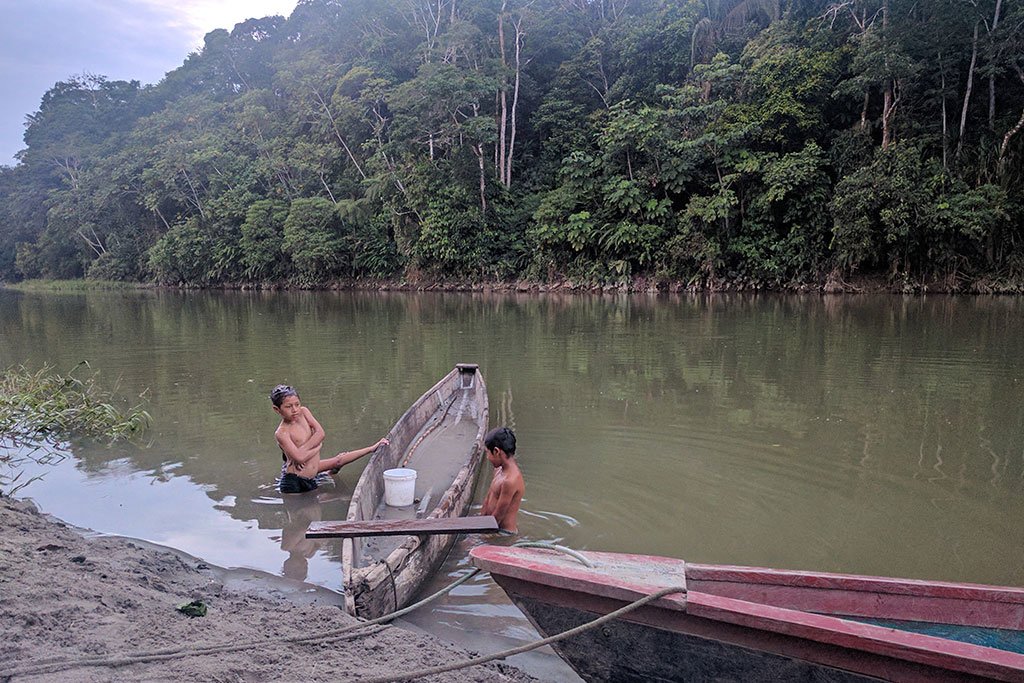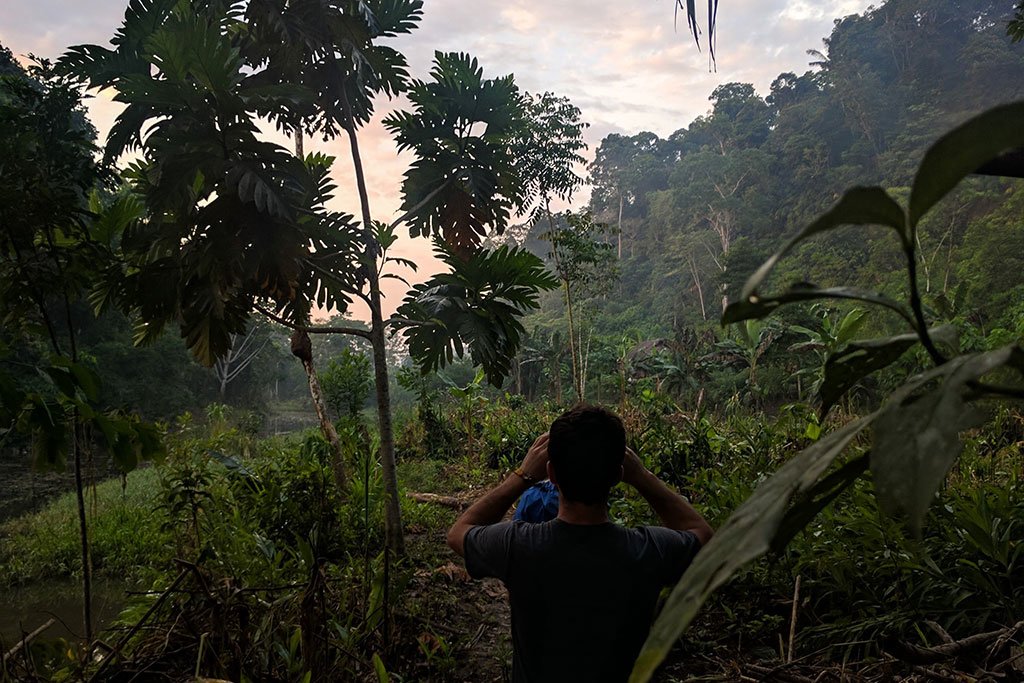Highlights
- Walk through a protected reserve of primary Amazon rainforest
- Learn about the local Kichwa culture through stories of local guides
- Choose from a variety of day activities catered to your interests
- Go birding on a beautiful jungle lagoons with dozens of bird species
- The money you spend goes directly to the local community
- Be guided by Bartolo Shiwango, the prior leader of the Chontayacu community who lived and acted as spiritual advisor to the community
Overview
Six hours’ drive from Quito will bring you to the Yacuma Ecolodge in the heart of primary Amazon rainforest. Depending on how much time you have, there are numerous activities to choose from.
The lodge itself is located on the bank of a small river which connects to one of the largest tributaries of the Amazon, the Rio Napo. There are sixteen bungalows, each with a private bathroom, comfortable bedding and mosquito nets, along with a kitchen house. On top of that, there is a communal fireplace, an open hut for relaxing in hammocks next to the river, and a bird-watching landing looking out above the canopy.
At the minimum, we recommend staying three days. If you're looking to explore deeper into the Amazon with a visit to Yasuni National Park, you'll need to stay for five days. Below, you'll find a list of great day activities that you can choose from to create a custom experience of the Amazon.
Choose your activities
Jungle Walks (2-4 hours)

From the lodge, there are a number of hikes to choose from, all of which take you into the primary jungle of the Yacuma Reserve. Along the way, a local Kichwa guide will explain and demonstrate how to harvest the main medicinal and consumable plants of the rainforest, while sharing stories about the history and folklore of the region.
The longer hikes will take you deeper into the jungle, heading to a sacred place known as the Tutapishco Cave, or Bat Cave. This walk takes about 4 hours and crosses streams and different types of terrain along the way. If you’re lucky, you’ll see wild animals such as the wild boars, Capybaras, monkeys and medium to large felines.
Another hiking option takes you through impressive Amazon landscapes to a beautiful waterfall that gives birth to the Chontayacu River (which runs next to the lodge). You will be able to hear the calls of the “Oropendola” bird, which has its nests hanging from trees in shapes of water drops.
Community tour (2 hours)

Local village homes are usually spread apart by 3-400 meters and have a small farm attached from which they derive their livelihood (cacao, plantains, corn).
You'll get to visit the home of one of the members of the local Kichwa community, where you can learn about the customs, history, and traditions of their community. Along the way, you'll pass through plantations of various crops that grow in the region such as coffee, bananas, cacao, cassava, and a variety of fruits.
Locals also produce handicrafts and souvenirs such as vases, small pots, necklaces and traditional jewelry, which are great gifts and mementos to bring back home. Here, we can also try the famous Chicha drink (known in North America as Kombucha), prepared in the traditional style leaving cassava and carrots to ferment.
Birdwatching (2 hours)

For those who are passionate about birdlife and the abundance of species in the jungle, an early morning rise is offered to take guests to see the first flights of the day at 5:30 am. This takes place from a viewpoint close to the lodge at one of the few salt licks in the region.
For another birding opportunity, you can head to the “Hidden Lagoon”, a location ideal for birdwatching. From the small canoes that are docked here, you'll observe a variety of jungle birds in their natural habitat. Among these birds are the Kingfisher, Great Egrets, Great Blue Herons, and one of the most interesting birds of the Amazon, the Hoatzin, which has a blue face and a Mohawk-style hairdo. You can also try your hand at fishing for Piranhas which can be later served for dinner if you manage to catch one!
Visit Yasuni National Park (Full-day)

Yacuma Ecolodge lies fairly close to the Yasuni National Park, an incredibly biodiverse region which harbors more species of flora and fauna per square mile than anywhere else on the planet. Yasuni National Park is also home to the Huaorani community, which has been living in this region for hundreds of years, living in nature and having little to no contact with the outside world until very recently.
To access the park, you’ll leave Yacuma at 8 a.m. for a 40-minute motorized canoe ride followed by an hour by vehicle to the Konimpade community. At the border of the Nushiño River, we will walk through primary forest observing plants and large trees as well as various species of birdlife. With some luck, we’ll see the larger mammals of the jungle. Finally, a 2-hour hike will take us to the Huaorani Goya Nenquino family.
You’ll be welcomed with a traditional dance by the community members before enjoying a packed lunch. After a short break, head off on a 20-minute walk to a salt lick where, if lucky, you can see the Guanta (Cuniculuc Paca) feeding. After enjoying the company of the Huaorani family, we return to Yacuma, where we enjoy our dinner and the last night in the jungles of Ecuador.
Water activities (1 hour)
While you're out on the Rio Napo, you may see locals panning for gold along the banks. In the above video, Bartolome demonstrates how this is done. They often collect up to 3 grams per day, selling it for $30 per gram at the local market.
Also, from the lodge, you can enjoy a variety of water-based activities, such as river kayaking, tubing, or simply swimming in the river. On the hot days, this is an excellent way to relax and avoid the heat!
Evening bonfire
You'll often close out the night after dinner with a bonfire with local music, legends, and stories, where we are all invited to share.
About the lodge




Built in 1995, Yacuma Ecolodge is located on Chontayacu River, a smaller tributary of the Rio Napo, one of the largest tributaries of the Amazon River. The lodge was established as a joint initiative with the Kichwa Indigenous Community of Chontayacu and EcoAndes. The main goal of the lodge is to help improve the economy of the community, preserve their natural environment, culture and heritage through sustainable tourism.
The first cabins were built using the traditional methods of construction used for hundreds of years in the Amazon by local jungle communities. These designs allowed for good air flow, creating a comfortable space to rest given the heat of the jungle.
Today, the design and utility of cabins is quite similar to the original cabins that stood here since the beginning of the project, but advancements in technology and materials have reduced the need for the use of old-growth trees. For example, long-lasting metal beams are now used for cabin framing to reduce the impact of deforestation, while other, fast-growing and low impact materials are sourced locally to the economy.
Other sustainable practices, such as organic farming, solar energy panels, water treatment plants and other small but effective projects have made Yacuma one of the lodges with the least environmental impact, and a socially-conscious project that returns more to the jungle and to its communities than what it takes.
Getting there & away

From the city of Tena, your guide will take you to the community of San Pedro de Sumino on the banks of the Napo River. This drive usually takes about 1.5 hours on a public bus service that is regularly scheduled from the city center. Alternatively, you can hire a private truck and driver. Gathering any required snacks and supplies at San Pedro, you'll head off on your adventure by river canoe into the Yacuma Forest Reserve.
Once you head up the Chontayacu river, you'll come up to the Yacuma EcoLodge which sits on the edge of a 275-hectare reserve — your home for the next few days. You will be welcomed by a refreshing glass of the traditional energy drink called “Guayusa”, packed full of caffeine and vitamins, giving a huge energy boost to those who enjoy its great taste. Next, you'll settle into your bungalow as you relax to the new sounds of the jungle.
When to go
The busy season for Yacuma Ecolodge is from May to September, given this is when most North Americans and Europeans have their summer holidays. If you're looking to have the entire lodge to yourself, consider visiting during the off-season (October to April). Keep in mind, the Amazon receives slightly more rain from October to April.


